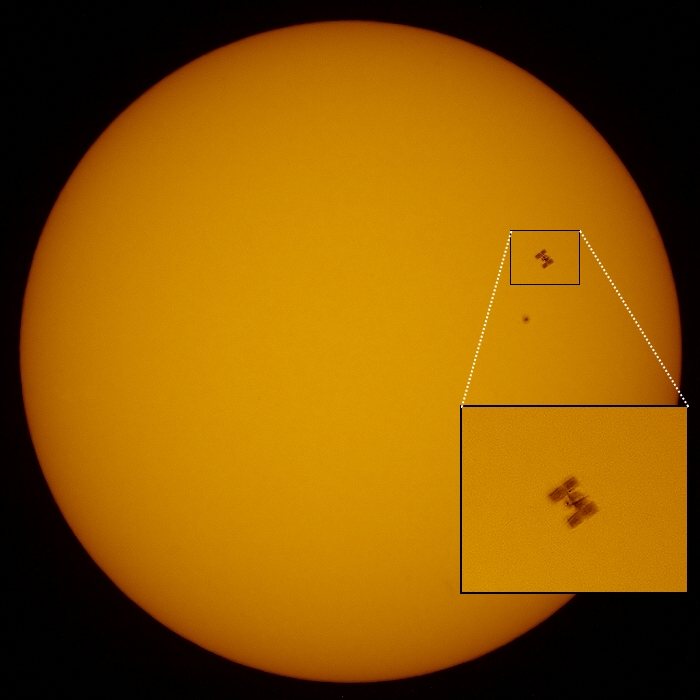
I have a particular interest in satellite transits across the solar/lunar surfaces due to the opportunity they present
the lucky observer to discern greater physical detail and structure as a result of their silhouette against the bright
background of the sun and/or moon; the ability to restrict the satellite's location in the daytime or evening sky to an
area measuring 0.5°x0.5° with little or no effort; it permits for the bypassing of satellite tracking which itself is a
challenge due the very short period transits are visible during a particular overhead pass; and the difficulty in
obtaining accurate and timely orbital elements and TLE's. As this "search and identify" project has literally become a
DAILY ritual, I expect this web page to be updated constantly with more and more images of the very unique phenomena of
satellite transits across the solar and/or lunar disks.
Note: The capture of a solar transit by the International Space Station was an incessant chase
for 3-4 years until July 28, 2005 when the ISS (with
STS-114)
was finally captured transiting against the Sun and which included the space shuttle Discovery. Approximately nine months
later, the ISS was also caught transiting the rising moon (click
here) albeit at a very low altitude.
The transit below involves the ISS and with the space shuttle Atlantis
(STS-132)
trailing by less than 23 seconds and one arc-degree. The primary purpose of STS-132 and its twelve-day mission was to
deliver and install two main modules to the ISS, namely the Integrated Cargo Carrier and a Russian-built Mini Research
Module (MRM-1) which is to be attached to the Zarya module. STS-132 represents Atlantis' eleventh and final flight to the
ISS and is to be retired from the active fleet immediately thereafter. The sunspot below the ISS is AR1072.
Note: Following my successful capture of the ISS with the space shuttle Discovery (STS-114)
transiting the sun on late July/2005 and which appeared on NASA's APOD (AstroPhoto of the Day,
July 29, 2005), I received many requests for
instructions in the identification and observation of similar opportunities and which are now fully documented
here.
Note: Unfortunately the presence of high thin cirrus clouds adversely impacted the
fine resolution which is normally possible otherwise.
|
Satellite(s): Int Space Station USSPACECOM Cat No: 25544 (ISS) Physical Dimensions: 73.0 x 44.5 x 27.5 m Orbit / Inclination: 351.3 x 355.1 km, 51.6° Range (Image): 432.4 km Angular Diameter: 42.8 " (ISS) Pass Details (ISS):
Launch Date (UTC):
|
 |
Date: May 25, 2010 10:43:55 UT+3 Location: Athens, Greece Equipment: AP 160 f/7.5 StarFire EDF AP 2x Convertible Barlow AP 1200GTO GEM Canon EOS 5D Mark I Baader UV/IR-Cut filter Baader ND-5 (full-aperture) Exposure(s): 1 x 1/2000 sec ISO 800 RAW image format 4368x2912 image size Continuous Servo Mode Manual Mode Software: Photoshop CS2 Processing: RAW to TIFF (16-bit conv) Grayscale Unsharp Masking Brightness/Contrast Levels Resampling Cropping JPG Compression |